Unit 5 First Aid Using Language(1) Listening and speaking(课件(共24张,内嵌音频)
文档属性
| 名称 | Unit 5 First Aid Using Language(1) Listening and speaking(课件(共24张,内嵌音频) | 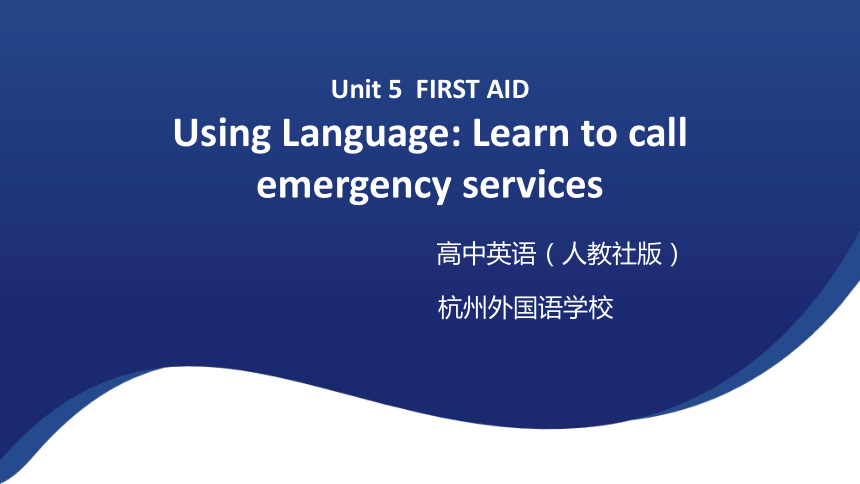 | |
| 格式 | pptx | ||
| 文件大小 | 22.4MB | ||
| 资源类型 | 教案 | ||
| 版本资源 | 人教版(2019) | ||
| 科目 | 英语 | ||
| 更新时间 | 2024-10-19 16:33:52 | ||
图片预览

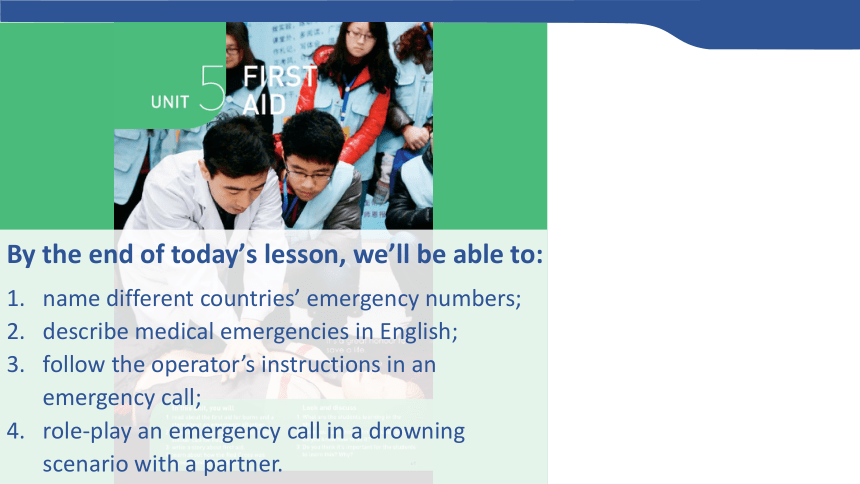

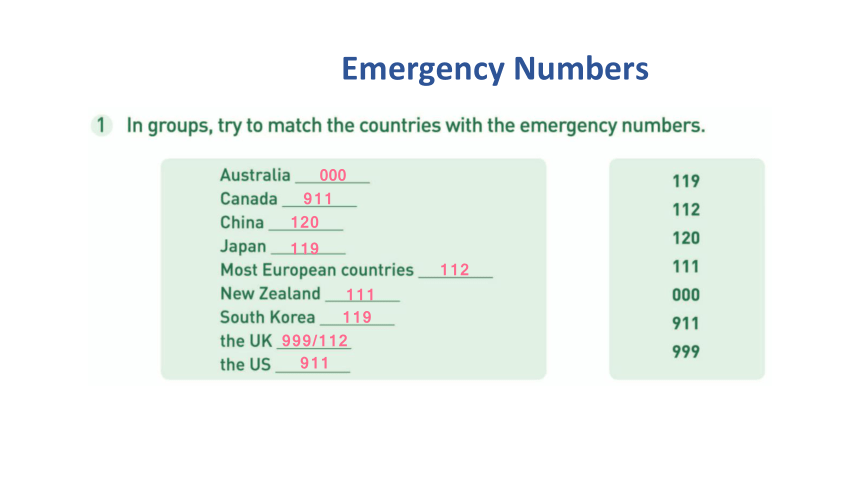
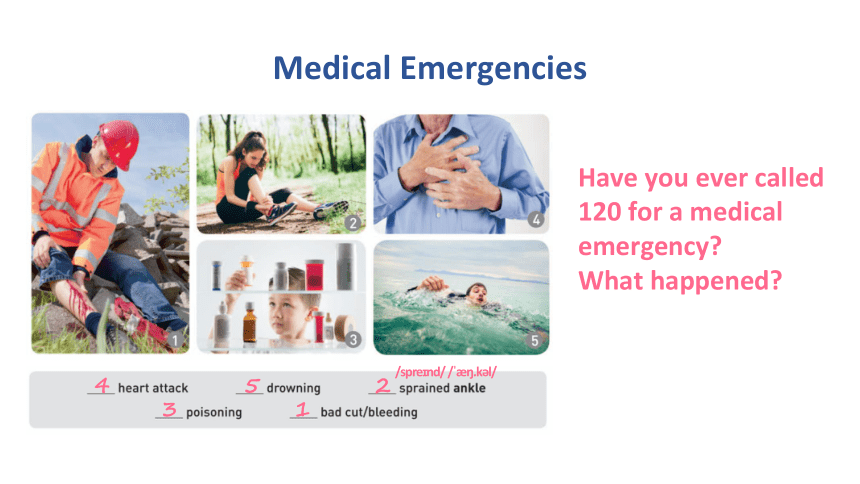
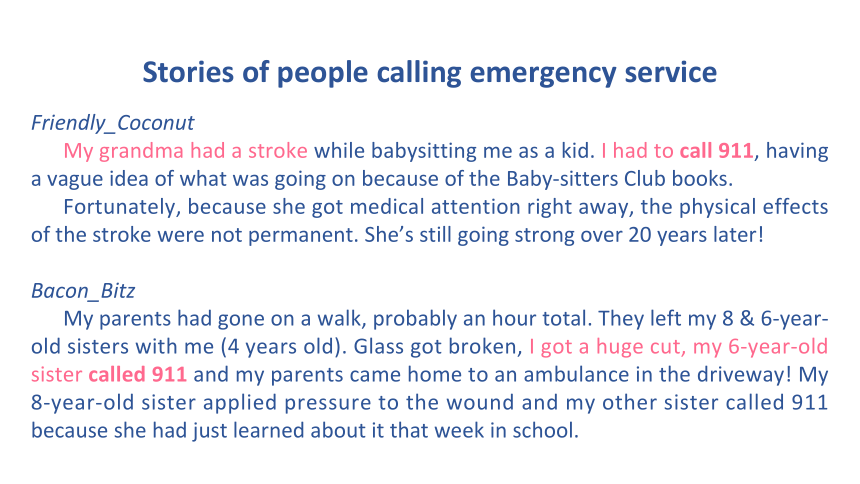
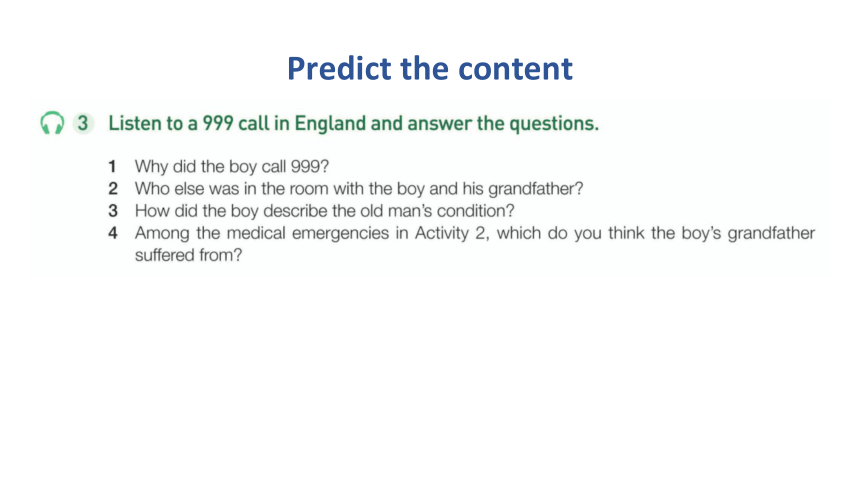
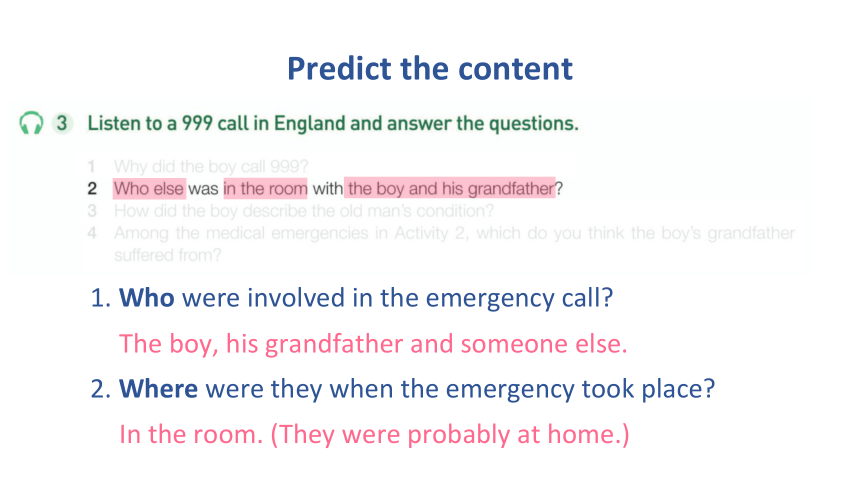
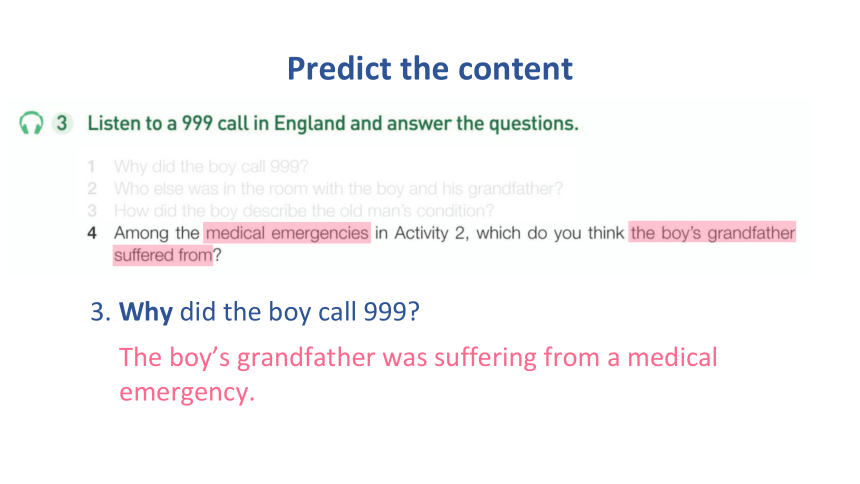
内容文字预览
(共24张PPT)
Unit 5 FIRST AID
Using Language: Learn to call emergency services
杭州外国语学校
高中英语(人教社版)
By the end of today’s lesson, we’ll be able to:
name different countries’ emergency numbers;
describe medical emergencies in English;
follow the operator’s instructions in an emergency call;
role-play an emergency call in a drowning scenario with a partner.
When do we call 120 in China
ambulance
medical emergency
Emergency Numbers
000
911
120
119
112
111
119
999/112
911
Medical Emergencies
1
2
3
4
5
/spre nd/ / .k l/
Have you ever called 120 for a medical emergency
What happened
Friendly_Coconut
My grandma had a stroke while babysitting me as a kid. I had to call 911, having a vague idea of what was going on because of the Baby-sitters Club books.
Fortunately, because she got medical attention right away, the physical effects of the stroke were not permanent. She’s still going strong over 20 years later!
Bacon_Bitz
My parents had gone on a walk, probably an hour total. They left my 8 & 6-year-old sisters with me (4 years old). Glass got broken, I got a huge cut, my 6-year-old sister called 911 and my parents came home to an ambulance in the driveway! My 8-year-old sister applied pressure to the wound and my other sister called 911 because she had just learned about it that week in school.
Stories of people calling emergency service
Predict the content
Predict the content
1. Who were involved in the emergency call
The boy, his grandfather and someone else.
2. Where were they when the emergency took place
In the room. (They were probably at home.)
Predict the content
3. Why did the boy call 999
The boy’s grandfather was suffering from a medical emergency.
Predict the content
4. Which medical emergency do you think the boy’s grandfather suffered from
Listen and check your predictions
Who: the boy, his grandfather and someone else( )
Where: in the room
Why: The boy’s grandfather was suffering from a medical emergency.
What: heart attack
his mother
Because his grandfather was having a serious health problem and they needed an ambulance.
The boy’s mother.
“... his breathing has gotten really bad ... I think he’s dying ... His face looks funny ... he’s started to breathe again ... his lips are blue ... He’s making strange noises ... He’s not breathing again ... he’s not breathing anymore!”
Perhaps he suffered from a heart attack.
Listen and number the instructions
panic (verb)
to feel so frightened that you cannot think or behave calmly
5
3
6
1
2
4
sequence adverbs
What made this call a success
Operator: Hello, this is the ambulance.
Boy: Hi, it’s my grandfather ... his breathing has gotten really bad. We need an ambulance!
Operator: OK. Could you tell me your address
Boy: 18 West Highgate.
Operator: And your phone number
Boy: Oh, it’s ... it’s 655-212. Please hurry! I think he’s dying!
Operator: Now calm down and tell me what’s wrong.
Boy: His face looks funny ... [Screaming] Granddad! Keep breathing! Help, please!
Operator: Right. How old is he
Boy: He’s 68.
Operator: And are you with him now
Boy: Yes. Me and my mother.
State the emergency.
Explain the purpose of the call.
Give the exact address.
Give the phone number.
Listen carefully to the operator’s questions and answer them.
How to make an emergency call -- The caller
Operator: I’ll tell you what to do. First, is he on his back
Boy: Yes, I just moved him on his back.
Operator: Next, remove any pillows.
Boy: OK. What next
Operator: Now look in his mouth. Any food there
Boy: No. Oh, he’s starting to breathe again!
Operator: So, he’s breathing
Boy: Yes, but his lips are blue! He’s making strange noises! Can you hurry
Operator: The ambulance is on the way. Is he conscious now
Boy: No. [Boy starts crying.] He’s not breathing again!
Operator: Listen to me! Next, tell your mum to put her hand in the middle of his chest, and press down.
Boy: Mum, put your hand in the middle of his chest and push down.
Operator: You need to do this quickly ... twice per second.
Boy: Twice per second, Mum! Hurry! Oh, he’s not breathing anymore!
Operator: Just be calm and do what I tell you. The ambulance is on the way. Press the chest twice a second. Keep doing it.
Boy: Keep doing it, Mum!
Operator: I know it’s very tiring. If your mother needs a break, you should change places.
Boy: Please hurry up! ... Oh, the ambulance is here! [Sound of a siren in the background.]
Operator: I can hear them. I can hear them.
Boy: Oh, thank you so much!
Follow the instructions given.
Operator: Hello, this is the ambulance.
Operator: OK. Could you tell me your address
Operator: And your phone number
Operator: Now calm down and tell me what’s wrong.
Operator: Right. How old is he
Operator: And are you with him now
Operator: I’ll tell you what to do. First, is he on his back
Operator: Next, remove any pillows.
Operator: Now look in his mouth. Any food there
Operator: So, he’s breathing
Operator: The ambulance is on the way. Is he conscious now
Operator: Listen to me! Next, tell your mum to put her hand in the middle of his chest, and press down.
Operator: You need to do this quickly ... twice per second.
Operator: Just be calm and do what I tell you. The ambulance is on the way. Press the chest twice a second. Keep doing it.
Operator: I know it’s very tiring. If your mother needs a break, you should change places.
Operator: I can hear them. I can hear them.
The location of the emergency.
The phone number .
The nature of the emergency
Details about the emergency.
How to answer an emergency call -- The operator
Caller:
State the emergency. (Tell the operator clearly what has happened.)
Explain the purpose of the call.
Give the exact address and phone number.
Listen carefully to the operator’s questions and answer them.
Follow the instructions given.
Operator may ask about:
The location of the emergency, including the street address.
The phone number you are calling from.
The nature of the emergency (What the emergency is).
Details about the emergency, such as a description of injuries or symptoms being experienced by the person having a medical emergency.
How to make an emergency call
What’s your emergency / What emergency are you reporting
What’s your location / What’s the address
Can you repeat it / So the address is ...
Is the patient male or female
How old is he / she
Is he / she conscious / breathing
Tell me exactly what happened. / What’s happening now
Are you with the patient right now
Are you alone
Is anyone helping / Is anyone giving CPR
Useful Sentences
Lay the victim on his back. Check for a response by patting his shoulders and talking loudly into each ear.
If he does not respond, call for an ambulance or have someone else do so.
Observe the victim’s chest for 5-10 seconds to check to see if he is breathing.
If the victim has breathing difficulties, check inside his mouth and remove any grass or sand. Then open his airway by gently lifting up his chin.
Perform mouth-to-mouth rescue breathing twice. Pinch his nose and cover his mouth with your mouth, and then blow air in for one second each time so that their chest rises slightly.
Perform CPR by clasping your hands together and pushing down on the centre of his chest thirty times, followed by two more rescue breaths. Continue the process until help arrives.
Pair work
Remember
In the call, the caller should:
State the emergency.
Explain the purpose of the call.
Give the exact address and phone number.
Listen carefully to the operator’s questions and answer them.
Follow the instructions given.
The operator should:
Ask about the location of the emergency, the phone number, the nature of the emergency and details about the emergency.
Give simple and direct instructions by using the imperative and sequence adverbs.
Calm the caller down if he/she is panicking.
Sample Conversation
O=Operator B=Boy
O: Hello, this is emergency.
B: Hi, it's my friend. We are at the swimming pool and I think
he's drowning. We need an ambulance!
0: OK. Could you tell me your address
B: We are at the pond in Zhongshan Park.
O: And your phone number
B: Oh, it's ... it's 138-1234-5678. Please hurry! I think he's dying!
0: And are you with him now
B: Yes.
0: I'll tell you what to do. First, is he on his back
B: No, he's on his side.
0: Well, you'll need to roll him over then. Can you do that
B: OK. What next
0: Now check for a response. When you call to him, does he
answer
B: No!
0: So, is he breathing
B: No!
0: Does he have a pulse Is his heart beating
B: Let me check ... no!
0: Listen to me! Turn his head to the side, and then put your
finger in his mouth to make sure that there is nothing in it.
B: OK ... I've done that.
0: Now turn his head back up, and lift his chin back.
B: Yes, OK.
0: Just be calm and do what I tell you next. The ambulance is
on the way. Breathe into his mouth until his chest rises. Do
this twice.
B: OK ... now what
0: Now push down on the middle of his chest really hard and
really fast. Every thirty pushes, stop and give him two more
breaths.
B: That's it
0: Yes, keep doing this until the ambulance arrives. And don't
hang up the phone! I'll be right here if you need more
help. The ambulance is on its way.
B: OK!
Polish the dialogue and get ready for class presentation.
Complete all exercises in the worksheet.
Assignment
Unit 5 FIRST AID
Using Language: Learn to call emergency services
杭州外国语学校
高中英语(人教社版)
By the end of today’s lesson, we’ll be able to:
name different countries’ emergency numbers;
describe medical emergencies in English;
follow the operator’s instructions in an emergency call;
role-play an emergency call in a drowning scenario with a partner.
When do we call 120 in China
ambulance
medical emergency
Emergency Numbers
000
911
120
119
112
111
119
999/112
911
Medical Emergencies
1
2
3
4
5
/spre nd/ / .k l/
Have you ever called 120 for a medical emergency
What happened
Friendly_Coconut
My grandma had a stroke while babysitting me as a kid. I had to call 911, having a vague idea of what was going on because of the Baby-sitters Club books.
Fortunately, because she got medical attention right away, the physical effects of the stroke were not permanent. She’s still going strong over 20 years later!
Bacon_Bitz
My parents had gone on a walk, probably an hour total. They left my 8 & 6-year-old sisters with me (4 years old). Glass got broken, I got a huge cut, my 6-year-old sister called 911 and my parents came home to an ambulance in the driveway! My 8-year-old sister applied pressure to the wound and my other sister called 911 because she had just learned about it that week in school.
Stories of people calling emergency service
Predict the content
Predict the content
1. Who were involved in the emergency call
The boy, his grandfather and someone else.
2. Where were they when the emergency took place
In the room. (They were probably at home.)
Predict the content
3. Why did the boy call 999
The boy’s grandfather was suffering from a medical emergency.
Predict the content
4. Which medical emergency do you think the boy’s grandfather suffered from
Listen and check your predictions
Who: the boy, his grandfather and someone else( )
Where: in the room
Why: The boy’s grandfather was suffering from a medical emergency.
What: heart attack
his mother
Because his grandfather was having a serious health problem and they needed an ambulance.
The boy’s mother.
“... his breathing has gotten really bad ... I think he’s dying ... His face looks funny ... he’s started to breathe again ... his lips are blue ... He’s making strange noises ... He’s not breathing again ... he’s not breathing anymore!”
Perhaps he suffered from a heart attack.
Listen and number the instructions
panic (verb)
to feel so frightened that you cannot think or behave calmly
5
3
6
1
2
4
sequence adverbs
What made this call a success
Operator: Hello, this is the ambulance.
Boy: Hi, it’s my grandfather ... his breathing has gotten really bad. We need an ambulance!
Operator: OK. Could you tell me your address
Boy: 18 West Highgate.
Operator: And your phone number
Boy: Oh, it’s ... it’s 655-212. Please hurry! I think he’s dying!
Operator: Now calm down and tell me what’s wrong.
Boy: His face looks funny ... [Screaming] Granddad! Keep breathing! Help, please!
Operator: Right. How old is he
Boy: He’s 68.
Operator: And are you with him now
Boy: Yes. Me and my mother.
State the emergency.
Explain the purpose of the call.
Give the exact address.
Give the phone number.
Listen carefully to the operator’s questions and answer them.
How to make an emergency call -- The caller
Operator: I’ll tell you what to do. First, is he on his back
Boy: Yes, I just moved him on his back.
Operator: Next, remove any pillows.
Boy: OK. What next
Operator: Now look in his mouth. Any food there
Boy: No. Oh, he’s starting to breathe again!
Operator: So, he’s breathing
Boy: Yes, but his lips are blue! He’s making strange noises! Can you hurry
Operator: The ambulance is on the way. Is he conscious now
Boy: No. [Boy starts crying.] He’s not breathing again!
Operator: Listen to me! Next, tell your mum to put her hand in the middle of his chest, and press down.
Boy: Mum, put your hand in the middle of his chest and push down.
Operator: You need to do this quickly ... twice per second.
Boy: Twice per second, Mum! Hurry! Oh, he’s not breathing anymore!
Operator: Just be calm and do what I tell you. The ambulance is on the way. Press the chest twice a second. Keep doing it.
Boy: Keep doing it, Mum!
Operator: I know it’s very tiring. If your mother needs a break, you should change places.
Boy: Please hurry up! ... Oh, the ambulance is here! [Sound of a siren in the background.]
Operator: I can hear them. I can hear them.
Boy: Oh, thank you so much!
Follow the instructions given.
Operator: Hello, this is the ambulance.
Operator: OK. Could you tell me your address
Operator: And your phone number
Operator: Now calm down and tell me what’s wrong.
Operator: Right. How old is he
Operator: And are you with him now
Operator: I’ll tell you what to do. First, is he on his back
Operator: Next, remove any pillows.
Operator: Now look in his mouth. Any food there
Operator: So, he’s breathing
Operator: The ambulance is on the way. Is he conscious now
Operator: Listen to me! Next, tell your mum to put her hand in the middle of his chest, and press down.
Operator: You need to do this quickly ... twice per second.
Operator: Just be calm and do what I tell you. The ambulance is on the way. Press the chest twice a second. Keep doing it.
Operator: I know it’s very tiring. If your mother needs a break, you should change places.
Operator: I can hear them. I can hear them.
The location of the emergency.
The phone number .
The nature of the emergency
Details about the emergency.
How to answer an emergency call -- The operator
Caller:
State the emergency. (Tell the operator clearly what has happened.)
Explain the purpose of the call.
Give the exact address and phone number.
Listen carefully to the operator’s questions and answer them.
Follow the instructions given.
Operator may ask about:
The location of the emergency, including the street address.
The phone number you are calling from.
The nature of the emergency (What the emergency is).
Details about the emergency, such as a description of injuries or symptoms being experienced by the person having a medical emergency.
How to make an emergency call
What’s your emergency / What emergency are you reporting
What’s your location / What’s the address
Can you repeat it / So the address is ...
Is the patient male or female
How old is he / she
Is he / she conscious / breathing
Tell me exactly what happened. / What’s happening now
Are you with the patient right now
Are you alone
Is anyone helping / Is anyone giving CPR
Useful Sentences
Lay the victim on his back. Check for a response by patting his shoulders and talking loudly into each ear.
If he does not respond, call for an ambulance or have someone else do so.
Observe the victim’s chest for 5-10 seconds to check to see if he is breathing.
If the victim has breathing difficulties, check inside his mouth and remove any grass or sand. Then open his airway by gently lifting up his chin.
Perform mouth-to-mouth rescue breathing twice. Pinch his nose and cover his mouth with your mouth, and then blow air in for one second each time so that their chest rises slightly.
Perform CPR by clasping your hands together and pushing down on the centre of his chest thirty times, followed by two more rescue breaths. Continue the process until help arrives.
Pair work
Remember
In the call, the caller should:
State the emergency.
Explain the purpose of the call.
Give the exact address and phone number.
Listen carefully to the operator’s questions and answer them.
Follow the instructions given.
The operator should:
Ask about the location of the emergency, the phone number, the nature of the emergency and details about the emergency.
Give simple and direct instructions by using the imperative and sequence adverbs.
Calm the caller down if he/she is panicking.
Sample Conversation
O=Operator B=Boy
O: Hello, this is emergency.
B: Hi, it's my friend. We are at the swimming pool and I think
he's drowning. We need an ambulance!
0: OK. Could you tell me your address
B: We are at the pond in Zhongshan Park.
O: And your phone number
B: Oh, it's ... it's 138-1234-5678. Please hurry! I think he's dying!
0: And are you with him now
B: Yes.
0: I'll tell you what to do. First, is he on his back
B: No, he's on his side.
0: Well, you'll need to roll him over then. Can you do that
B: OK. What next
0: Now check for a response. When you call to him, does he
answer
B: No!
0: So, is he breathing
B: No!
0: Does he have a pulse Is his heart beating
B: Let me check ... no!
0: Listen to me! Turn his head to the side, and then put your
finger in his mouth to make sure that there is nothing in it.
B: OK ... I've done that.
0: Now turn his head back up, and lift his chin back.
B: Yes, OK.
0: Just be calm and do what I tell you next. The ambulance is
on the way. Breathe into his mouth until his chest rises. Do
this twice.
B: OK ... now what
0: Now push down on the middle of his chest really hard and
really fast. Every thirty pushes, stop and give him two more
breaths.
B: That's it
0: Yes, keep doing this until the ambulance arrives. And don't
hang up the phone! I'll be right here if you need more
help. The ambulance is on its way.
B: OK!
Polish the dialogue and get ready for class presentation.
Complete all exercises in the worksheet.
Assignment
